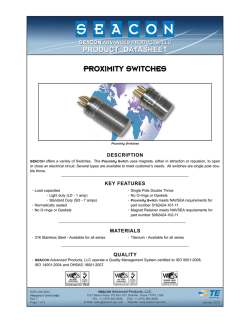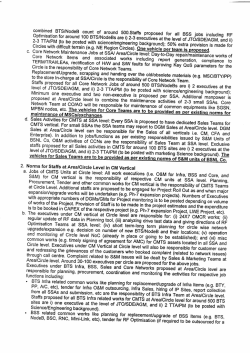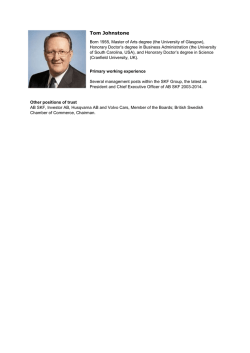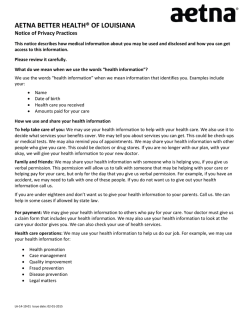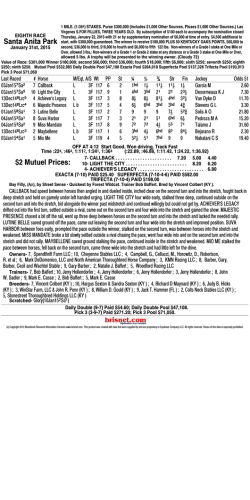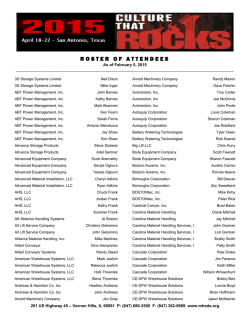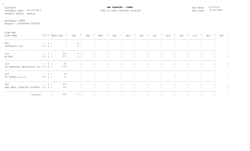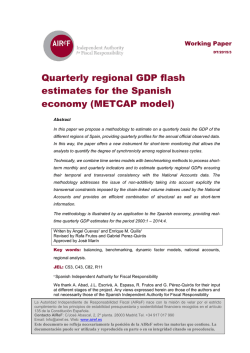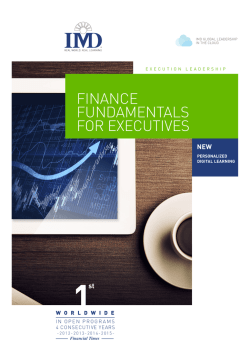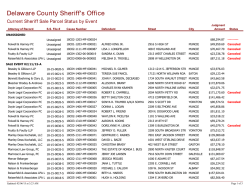
download (pdf) - Insigniam Quarterly
46 1 ® INSIGNIAM INSIGNIAMQUARTERLY QUARTERLY COPYRIGHT © INSIGNIAM HOLDING LLC. ALL RIGHTS RESERVED. REPRINTED WITH PERMISSION. WINTER 2015 THE HEALTH 2.0 REVOLUTION Rapid advances in technology are upending traditional health care models. BY CHRIS WARREN WINTER 2015 COPYRIGHT © INSIGNIAM HOLDING LLC. ALL RIGHTS RESERVED. REPRINTED WITH PERMISSION. INSIGNIAM INSIGNIAMQUARTERLY QUARTERLY 47 2 billion in annual revenue and a network of 19,000 physicians serving nearly 10 million patients in eight states and the District of Columbia. Nor is Tyson the only health care executive who has mounted the Health 2.0 stage to cheer on tech disrupters. At an earlier conference, Mark Bertolini, chairman, CEO and president of health insurer Aetna, cheekily prefaced his presentation by stating,“I’ll show you some pretty cool new technology that we’re using to empower health systems to put insurers out of business.” To put it mildly, the CEOs of Aetna and Kaiser Permanente he scene would have been unimaginable as little as a were not the sort of speakers who addressed the first Health 2.0 decade ago. At this past fall’s Health 2.0 conference in Silicon conferences in 2007. Launched with the mission to identify Valley, Bernard Tyson stood on the stage and exhorted audience and harness so-called Web 2.0 technologies — think cloud-based, members to fundamentally upend an industry. His industry. user-friendly software platforms like Facebook that enable social “Many of you are hoping to innovate and disrupt the health care sharing — to engage and improve health care for practitioners and industry. And I am actually looking forward to your great success patients alike, Health 2.0 originally attracted mostly tech companies in totally turning the health care industry upside down,” Tyson such as Google, Microsoft Health, and WebMD. “It wasn’t the health told the attendees, a mixture of big and small tech players as well care establishment paying attention at all,” says Indu Subaiya, co-chair as representatives of a cross-section of health care companies. and CEO of Health 2.0, which today hosts a series of worldwide conferences that bring together It’s not unusual in the least to hear people in SiliconValley health care and tech leaders and runs an intelligence service cheerlead the upending of even the biggest of industries. that tracks thousands of new health technology companies. From banking to real estate to retail, disruption fueled by “Slowly, over the years they learned if they weren’t paying innovation and technology is at the core of the valley’s attention to this, they realized their business would ethos. But what made this call for disruption in health care fundamentally change for the worse.” so notable was the person who made it. Far from being a Obviously, much has changed since those first conferences. scrappy entrepreneur, Tyson is the chairman and CEO of There are already countless examples of technology altering Kaiser Permanente, the health care consortium with $50 and improving the patient experience and health care 48 3 ® INSIGNIAM INSIGNIAMQUARTERLY QUARTERLY COPYRIGHT © INSIGNIAM HOLDING LLC. ALL RIGHTS RESERVED. REPRINTED WITH PERMISSION. WINTER 2015 The charge to integrate Health 2.0 is driven by a desire to improve communication, information, and ultimately quality of care, between doctors and patients who are tapping into the latest technologies. delivery. In many ways, says Subaiya, the technology that is making an impact follows the classic disintermediation model that, in the past, has allowed people to make their own plane reservations without a travel agent and manage their savings and investments without a banker. “There are a whole number of companies that call themselves the Uber of health care,helping make a connection to a doctor faster and easier,” she says. She cites the example of Doctor on Demand, which enables consumers willing to pay a small fee to have a 15-minute virtual consultation with one of the thousands of physicians in the company’s network. “That concept of having immediate access to a doctor is going to be radical in terms of changing things.” Subaiya believes patient empowerment via technology will only grow in the future and, in many instances, will be key in helping health care providers improve care. For instance, patients with sensor-enabled smart phones will do everything from monitor their heart rate and blood pressure to administer a high-quality EKG or eye examination. “Companies like Ginger.io use the phone to track whether you are at risk of depression or suicide because it knows if you left your house over a period of days,” she says. When all of this patient data being generated is shared with doctors WINTER 2015 and nurses, it can be acted upon to alter and improve care on a day-to-day basis.Technology then instantly makes patients an integral partner in their own care. But individual data generated by patients represents a single aspect of technology’s promise for improving health care delivery and the patient experience. Kaiser Permanente is just one of many providers to use data analytics to examine and alter its approach to what’s broadly known as population health management.“Whether it’s a hospital administrator or doctor or health plan or executive, it’s impossible to look at data from thousands of people to find patterns and say, gosh, of all the patients I have with diabetes, 40 percent aren’t where they need to be.What can I do?” says Subaiya. “Or, if you’re a health plan you can see that doctors in your network are prescribing services that are costing a lot of money but aren’t delivering results. Tools that allow mass data examination and data visualization will become increasingly important.” The examples go on and on — witness the Mayo Clinic’s use of iPads to monitor their heart patients as they make the transition from the hospital to their homes, or clothing that tracks people’s heart rates, breathing, and calories burned. While exciting in many ways, the advent of so much technology poses real challenges to health care leaders charged COPYRIGHT © INSIGNIAM HOLDING LLC. ALL RIGHTS RESERVED. REPRINTED WITH PERMISSION. INSIGNIAM INSIGNIAMQUARTERLY QUARTERLY 49 4 with identifying and implementing tools that will provide Companies, including Health 2.0, offer vetting services so genuine benefits.“Executives face information overload,” says that leaders can be sure that technologies have gone through Subaiya. “They know there’s a lot of innovation out there, the appropriate validation steps and been tested with actual but they just don’t know where to begin.” patients.When a promising technology is identified, Subaiya One place to start, she says, is with some rigorous self- suggests experimenting with it in your company.“Executives examination. What exactly do you and leaders need to be willing to want technology to accomplish? experiment in small ways.You don’t What problems can it solve? How have to go crazy, you don’t have does it help doctors and nurses to make a big splash. You can try provide the kind of care they want something in small groups and share to deliver? “A huge piece of advice what you learn.” is to look for inefficiencies in your There are two other major system that frustrate employees temptations Subaiya says are and consumers,” she says. At MD important for leaders to resist Anderson in Houston, notes when evaluating and implementing Subaiya, there is a small department technologies. One is the notion that “THERE ARE A WHOLE of innovation whose mission is to your operations are so unique that NUMBER OF COMPANIES observe how the business runs and only a custom-made solution will THAT CALL THEMSELVES identify hurdles and irritants that get the job done.“Nothing frustrates could be addressed with technology. entrepreneurs more than having a THE UBER OF HEALTH “Before you rush out to buy the good product and going into a CARE, HELPING MAKE latest new technology, study your hospital or insurance company and A CONNECTION TO A own culture and create a department having them make it completely DOCTOR FASTER AND that doesn’t necessarily need to be their own in a way that doesn’t allow part of the traditional org chart and you to share data and connect with EASIER. THAT CONCEPT that reports very high up in the the rest of the health care system, OF HAVING IMMEDIATE organization,” she says. which is so important in health,” she ACCESS TO A DOCTOR IS Actually pinpointing technologies says.“When making a decision about that can be helpful is also a challenge implementing a solution, really ask GOING TO BE RADICAL leaders face. Fortunately, there are yourself if you have looked out there IN TERMS OF CHANGING plenty of avenues to search out to see if there is something that is THINGS.” what is new. Subaiya recommends close enough that exists? We see so — INDU SUBAIYA executives take a close look at what much reinvention of the wheel, it’s early-stage investors are supporting staggering.” as well as the kinds of companies that In a more general sense, Subaiya are working with digital health incubators, including Rock insists that executives considering health care technologies Health and Healthbox. Subaiya says it can also be helpful to need to embrace a big-picture perspective. “Don’t make keep an eye on the grants the federal government awards to shortsighted decisions around technology that promise innovative health technology startups. But don’t be limited you market share at the risk of compromising quality,” she by geography. “Tomorrow’s innovative startup might come says. For instance, Subaiya would warn against embracing a out of Bangalore, India, not SiliconValley,” she says.“Educate technology that would limit doctors to referring patients yourself and be open to innovation and don’t expect it to only to specialists within their network.“While that is a tool come to you.” that can help an executive technically claim they kept dollars Wherever the technology idea comes from,though,Subaiya within their system, it may not be a tool that helps patients believes executives need to be clear that there’s something get the best care,” she says. Instead, promoting the greatest more substantial there than just an idea.“You have to examine levels of transparency and choice should guide executives. technologies carefully for data. Have they been tested in “Because at the end of the day, that will drive better outcomes situations that resemble your own environment?” she says. and allow you to have the reputation you want to have.” 50 5 ® INSIGNIAM INSIGNIAMQUARTERLY QUARTERLY COPYRIGHT © INSIGNIAM HOLDING LLC. ALL RIGHTS RESERVED. REPRINTED WITH PERMISSION. WINTER 2015 WINTER 2015 COPYRIGHT © INSIGNIAM HOLDING LLC. ALL RIGHTS RESERVED. REPRINTED WITH PERMISSION. INSIGNIAM INSIGNIAMQUARTERLY QUARTERLY 51 6
© Copyright 2025

